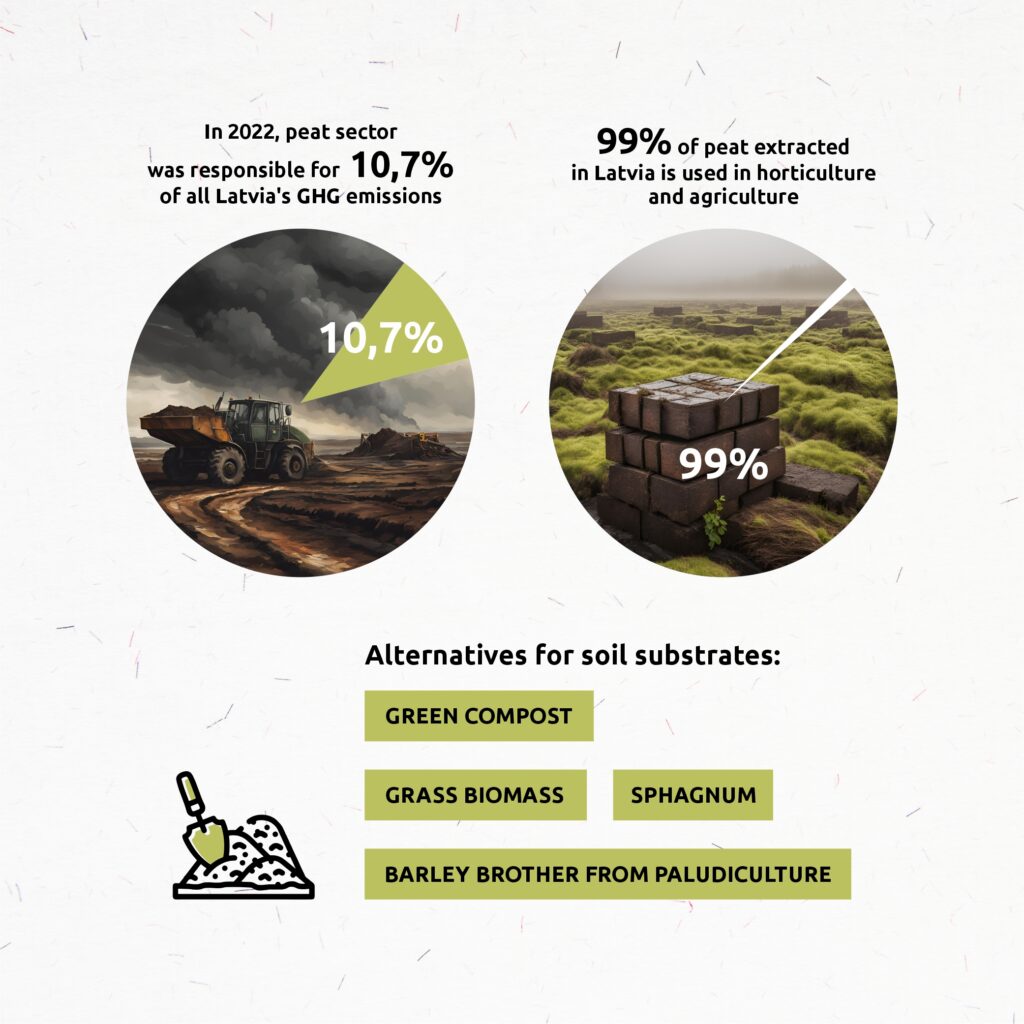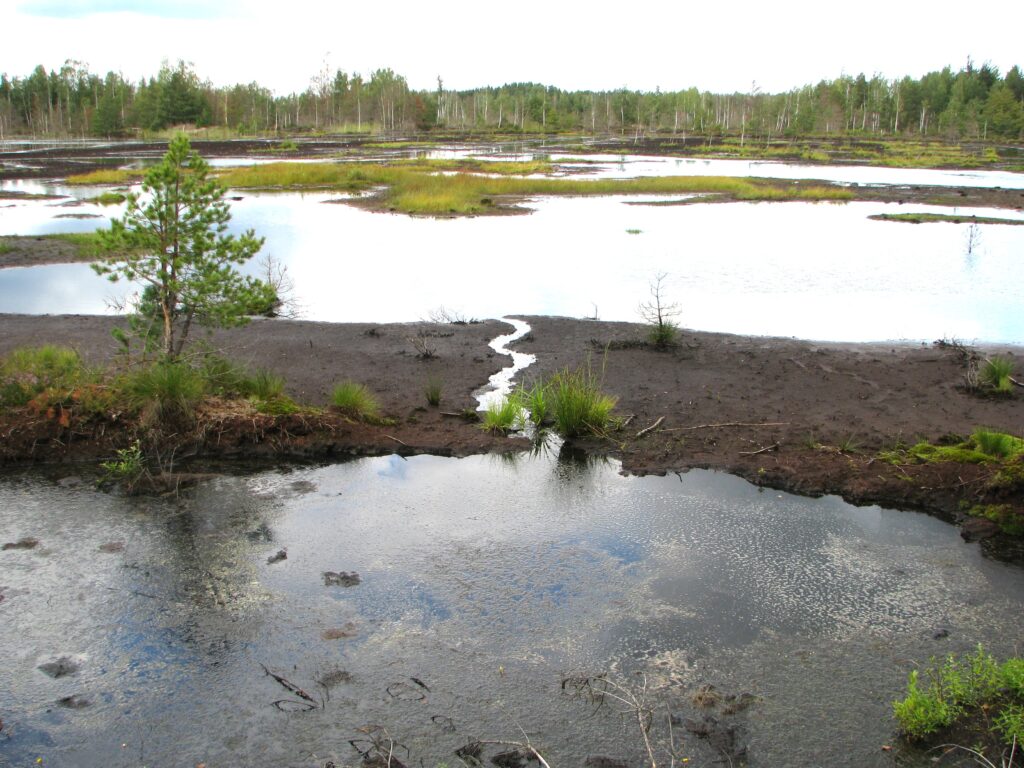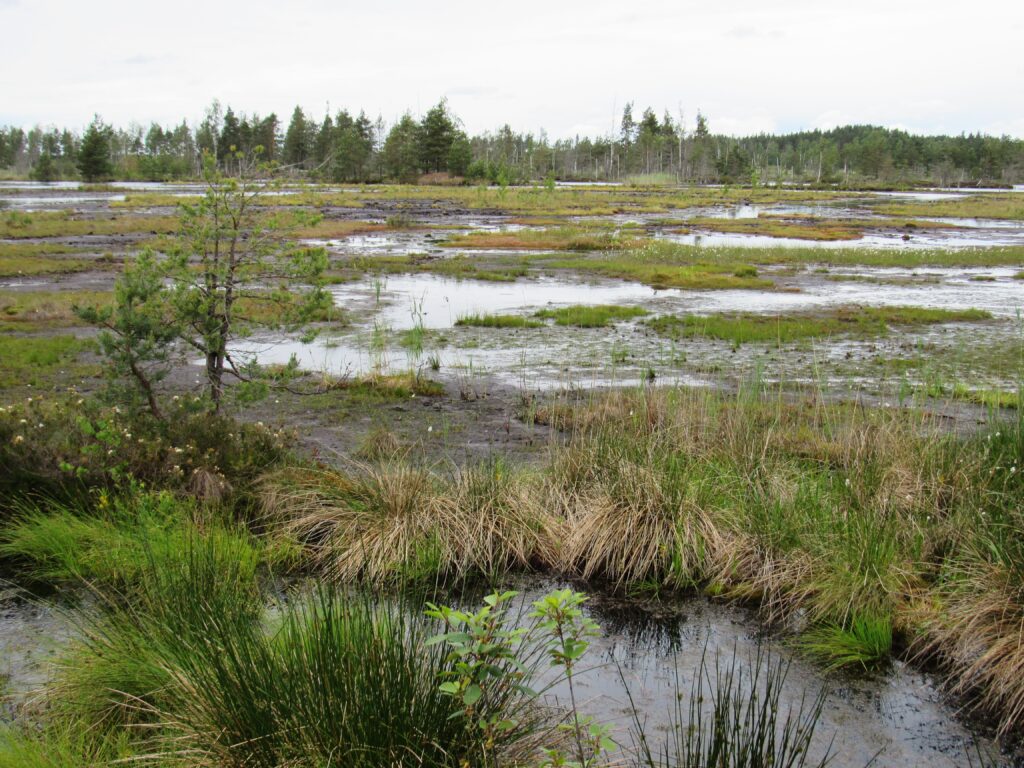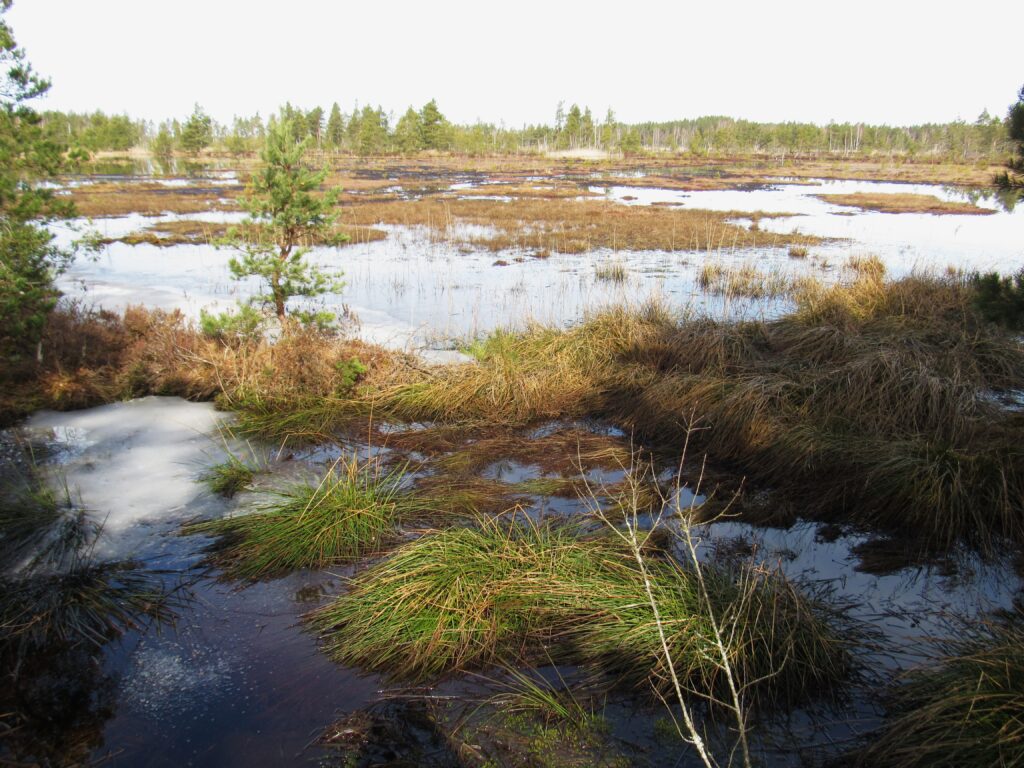The need for phasing out peat to reduce climate crises: Latvia’s challenges and opportunities
Story by Maksis Apinis, energy transformation campaigner, Latvia
The most significant uses of peat in the world are for the creation of soil substrates and the production of energy. In 2022, the peat sector was responsible for 10.7 per cent of Latvia’s total greenhouse gas emissions. Peatlands store twice as much carbon as forests worldwide.
Peat is an accumulation of partially decayed vegetation or organic matter formed in bogs. It forms in regions with gently undulating terrain (with many small depressions) and where precipitation exceeds evaporation. Bogs are mainly formed by the overgrowing of water bodies or by the swamping of land. Peatlands store twice as much carbon as forests worldwide and therefore play a very important role in regulating the climate.
Over the past seven years, peat extraction in Latvia has increased significantly. In 2021, as much as 2.2 million tonnes were exported, making Latvia a global leader in the export volume of peat and peat products from 2019 to 2023. A very active peat extraction industry is the reason for Latvia’s inclusion among countries with just transition regions.
The main problem with peat is that it is a fossil material, meaning it contains carbon captured from the atmosphere up to several thousand years ago, and therefore, like coal, gas or oil, it contributes to global warming when the carbon is released back into the atmosphere. New peat is forming in bogs; however, the process is too slow in the context of the urgency of climate change for this material to be considered renewable. Once a bog is drained – which is necessary in order to prepare an area for peat extraction – the peat layers are no longer water-saturated and are exposed to oxygen, which greatly speeds up the decomposition process, leading to carbon being released.
In 2022, 10.7 per cent of all greenhouse gas emissions in Latvia’s balance came from the peat sector – from extracted peat, active peat extraction fields, former but unreclaimed peat extraction fields, and peat used for energy. This is a very significant share generated by one sector, considering that the peat sector employs only 2,000 people, almost a third of whom are seasonal workers. This sector contributes around 1 per cent to Latvia’s gross domestic product.
Main uses of peat
Historically, all across the globe until the middle of the last century, peat was mainly only used for energy production. In the second half of the last century, peat became the main component of soil substrate, which is used in horticulture, in agriculture and in forestry for seedlings. Peat has excellent properties that make it very suitable for growing seedlings – it is homogeneous, with good and predictable physical properties, and there are no impurities, such as weed seeds or pathogens. In addition, it is cheap; however, this is due to the fact that the price of peat does not include all the external costs to the environment and nature that arise from its extraction. At the moment, peat has an important role in growing seedlings – both for food and in the forestry industry.
Latvia is one of six EU Member States that still use peat for energy production. Peat played an important role in the energy sector in Latvia up until 2002, when it was replaced by fossil gas in the largest (at the time) cogeneration plant in Latvia, which provided heating to the capital city of Riga. Thus, in 2022, compared to 1990, peat consumption in the energy sector had decreased by 97.1 per cent. Currently, only approximately 0.5 per cent of the peat extracted in Latvia is used for energy production, and the share of peat in total energy consumption in Latvia in 2023 was only 0.09 per cent. Funds from the Just Transition Fund will now be used for the transition from peat-burning boilers to renewable energy technologies in the two remaining municipalities that still use peat for energy.
Exports and chief consumers
In total, around 80 per cent of all peat extracted in the world is extracted in Europe. All peat consumed in the EU is extracted in EU countries. Latvia exports around 95 per cent of all peat extracted in its territory, and only a small amount remains for local consumption. Data on the extent of peat extraction, peat substrate production, export and import are incomplete and cannot yet be accurately tracked due to data recording deficiencies.1 However, in terms of export market share, Latvia was the global leader in terms of export volume of peat and peat products between 2019 and 2023. Latvia is followed by Canada, Germany, Estonia, Lithuania and the Netherlands.
Peat for energy purposes is not actually exported by any country; that is, it is consumed in the same country in which it is extracted. In contrast, non-energy peat is exported on a large scale from northern Europe (including the Baltic States) to western Europe. The largest consumers of peat in Europe are Germany and the Netherlands.
1. There are countries that extract and export peat in an unprocessed form, while the production of peat substrate, used, for example, in horticulture, may take place in another country, which then exports this product further. There are also difficulties with accurate peat accounting due to the admixture of other materials in the peat substrate and the amount of water in the peat.

Climate impact and achieving emission reduction targets
Peat extraction and bog degradation is one of the threats to climate stability. Carbon dioxide emissions are generated: 1) during the combustion of the extracted peat for energy, 2) during the mineralisation of the extracted peat from its use in non-energy applications, such as horticulture and forestry and 3) during the mineralisation of peat soils at the extraction site. The total EU emissions from peat used in energy production and horticulture in 2019 were 21.4 million tonnes of CO2-eq (not including abandoned peat extraction fields), which is equivalent to emissions from five million gasoline-powered cars in one year.
Natural peatlands may generate additional emissions of methane in the short term, but in the longer term (several decades), natural and restored peatlands are carbon sinks with a positive overall impact on the climate.2
From the perspective of limiting the climate crisis, it is essential that any opportunity to reduce emissions and capture additional carbon is used. In order for Member States to achieve climate neutrality by 2050, or even sooner, the land use, land use change and forestry (LULUCF) sector must become a carbon sink. This is necessary in order to compensate for emissions from other sectors that cannot be eliminated.
The LULUCF Regulation sets emission reduction and carbon sequestration targets for this sector for each Member State by 2030. In turn, the Effort Sharing Regulation sets the annual emission allowances for each Member State and a trading mechanism between Member States for sectors not included in the emissions trading system, including LULUCF. If a Member State fails to reduce emissions from the LULUCF sector, it will have to purchase unused emission allowances from other EU Member States, which will not be cheap (if they are available at all), given that reducing emissions in this sector is a particularly big challenge for almost all Member States. In addition, the Renewable Energy Directive sets out a requirement for emissions from the LULUCF sector not to exceed carbon removals in order to count forest biomass as a renewable resource. If Latvia failed this requirement, it would be devastating for the country’s renewable energy targets, since most of the heating sector relies on forest biomass.
Since there are no significant trade flows of peat between the EU and the rest of the world, the risk of carbon leakage could be mitigated by developing a coordinated European strategy to address the climate impact of non-energy peat. As Europe is by far the largest region affected by peat extraction, the EU has a major responsibility to mitigate its climate impact.
2. This is because methane, though it has significantly higher greenhouse effect potential, spends a significantly shorter period of time in the atmosphere (12 years) than carbon dioxide (300-1,000 years); therefore, the role of bogs in maintaining climate stability differs when comparing different time periods.
Impact on biodiversity
The direct impact on biodiversity from peat extraction comes from the destruction of bog ecosystems, first by draining them and then by digging up their peat layer. After peat extraction, the area is degraded and needs to be remediated. The most beneficial strategy for biodiversity, if possible in a given location, is the renaturalisation of the bog.
Around half of the EU’s 35 million hectares of peatlands are classified as degraded due to peat extraction and drainage for agricultural and forestry purposes. For these reasons, western European countries have either stopped peat extraction or have significantly reduced it and are importing peat instead. In Germany, as much as 95 per cent of peatlands have been drained or destroyed, while in the Netherlands it is 99 per cent.
Peat substrate alternatives
There are promising alternatives to peat that work well. In western European countries, peat-free soil substrates are already available, at least for hobby gardeners. Wood fibres, green compost, coconut fibres, perlite and bark have long been established as ingredients in substrate mixtures (50 per cent of the substrate), and they can be used in increasing proportions. Hybrid substrate mixtures are approaching the bar of pure peat products in terms of quality. Stone wool is widely used for growing vegetables and other crops. Other more sustainable alternatives that are being studied include grass biomass, sphagnum and barley sphagnum from paludiculture. Sphagnum grown in paludiculture could replace peat 1:1 without additional additives due to its properties. With regard to substrate alternatives, it is essential to assess the full life cycle of the raw material and find solutions that are most suitable in terms of quality, environmental impact and cost. In this regard, for example, the use of coconut fibre is not a sustainable solution due to the long transport route, as it is imported from India, Sri Lanka and the Philippines.
The use of peat in the production of substrates for horticulture, forestry and agriculture needs to be gradually reduced, and by 2050 at the latest, the composition of soil substrates must be completely free of peat. It is necessary to set mandatory targets at the European Union level for the gradual reduction of the proportion of peat in soil substrates.
Currently, customers in western European countries are demanding a reduction in the carbon footprint of soil substrates. In 2023, the German government approved an action plan for nature-based climate and biodiversity solutions, which, among other things, stipulates a transition to peat-free substrates in commercial horticulture by 2030 and a gradual transition in private horticulture as early as 2026. These goals are to be achieved through agreements and voluntary measures. In the Netherlands, the sector has also agreed to move towards the development of sustainable planting materials, although with less ambitious goals than Germany.
At the same time, an important aspect to consider is the global increase in the demand for soil substrate, which is related both to the economic development of other (non-EU) countries and to soil degradation and desertification in the Mediterranean region due to climate change. The peat industry believes that alternatives are needed not to replace peat, but to avoid increasing its extraction. However, in the long term, it would be unacceptable to solve the problems caused by climate change with a means that itself causes these adverse changes.
The main obstacles preventing soil substrate producers from using alternatives more widely are the insufficient availability of alternative substrates in terms of volume and the lack of guaranteed quality standards. However, assessing the availability of alternatives and the progress of research in this area, it can be concluded that replacing peat completely will be possible in the future, and that to overcome these obstacles, more ambitious and supportive policies are needed – for example, by creating regulatory conditions and incentives that promote the production of renewable, regionally produced, affordable and high-quality substrates.
It is necessary to promote international-level, large-scale research into alternatives for soil improvement and plant growth technologies, and to find solutions that are suitable in terms of quality, environmental impact, and cost.
Remediation of former peat extraction fields
A significant source of emissions includes former peat extraction sites that have not been remediated (the water table has not been restored to its previous state). Currently, 26,232 hectares of historical peat extraction sites in Latvia require remediation. The bog ecosystems in some of these areas have already undergone natural regeneration or have naturally become reforested, but data on these areas is currently lacking.
The current scientific consensus on the most climate-friendly remediation method is the restoration of the hydrological regime characteristic of bogs and their renaturalisation, where this is possible. This method significantly reduces CO2 emissions associated with peat extraction and makes these areas a carbon sink with equivalent or even greater sequestration potential than intact bogs. The restoration of the hydrological regime goes well together with establishing paludiculture for sphagnum farming. However, other remediation methods are often considered – such as afforestation or the planting of berry bushes and grasslands – which at present bring more economic value for the landowner. As of now, there is insufficient scientific information on the resulting climate impact of these other types of land use, though there are credible studies that show that the afforestation strategy, taking into account a full life cycle analysis, would be unfavorable for the climate.
Further voluntary carbon credit market development could promote renaturalisation projects for degraded bogs, creating a financial incentive for landowners to choose the reclamation method, which most benefits the climate. The Riga municipality enterprise Rīgas meži, which manages large areas of historical peat extraction sites, is looking into the carbon credit market as a means of helping the city of Riga reach climate neutrality.
Latvia will now use the Just Transition Fund to renaturalise former peat extraction areas, which are part of Natura 2000 sites, as well as to create and implement remediation plans in historically degraded areas belonging to municipalities and private owners that lie outside of natural protected areas. Another investment under the Just Transition Fund will fund research on the needs of the peat industry in transitioning to climate neutrality.3 However, there is still a high risk that this investment might include research on new peat products, portraying them as a way to capture carbon; this would certainly not be in line with the ‘do no significant harm’ principle, as it would promote the extraction of peat, and in addition, the long-term storage of carbon in products is questionable. There is also a risk that these funds could be used to appropriate science in favour of the economic interests of the peat and forestry industries, attempting to ‘prove’ that peat extraction creates fewer emissions and that afforestation and berry planting is better for the climate than renaturalisation or the restoration of hydrological regimes.
The Just Transition Fund is an excellent opportunity for Latvia to invest in peat-free soil substrate research, as well as to remediate historical peat extraction sites in order to maximally benefit the LULUCF sector’s emission reduction and carbon sequestration. However, it is also crystal clear that joint EU action is needed for a planned phase-out of peat in soil substrates, as the most meaningful factor in peat sector transformation will be changes in demand; but the greatest demand for peat and peat products comes from western European countries, which, furthermore, have almost fully ceased extraction in their own territories and thus do not carry the burden of associated carbon emissions.
3. The research will include improving the calculation method for Latvia’s GHG emissions and CO2 sequestration in the peat extraction sector, new and innovative solutions for the reclamation activities of degraded bogs, new technologies and products to promote climate neutrality in the peat sector, and creating innovative and alternative solutions focused on carbon capture and promoting their wider use, including research into new types of peat and other substrates.
An example of successful bog habitat restoration at a former peat extraction site in Ķemeri National Park in Latvia:
In 2006 the restoration of the abandoned peat fields on the northeastern edge of Lielais Ķemeri Mire took place, funded by the LIFE Programme.
From the 1950s to the 1980s, peat was extracted at the site using the milling method over an area of 46 ha. After extraction activities ended, the post-milling peatland was abandoned for nearly 25 years without any intervention. It remained a degraded area with a highly modified hydrological regime and a water table ~0.5 metres below the peat surface, hindering the recovery of bog vegetation andresulting in the gradual decomposition of peat and the release of fossil carbon.


Prior to the restoration works, which included the elevation of the water table and the rewetting of the peat milling fields, vegetation was sparse, largely dominated by bare peat. Restoration measures consisted of building both dams with culverts and peat dams, which resulted in the water table rising by 0.6 metres.
The re-establishment of sphagnum is among the main indicators of successful restoration. Over a period of six years, the presence of sphagnum increased considerably in the rewetted plots. The bog restoration in Lielais Ķemeri Mire was largely successful. The rewetting of the peat milling fields induced rapid vegetation changes leading to plant communities typical of bog hollows, transitional mires and fens. Carbon dioxide and methane emissions from bare and sparsely vegetated peat also diminished, and fire risks characteristic of dry peat fields were prevented.

